You’ve heard the saying: Monkey see, monkey do… Well, the monkeys have been busy trying to copy the success of the PalmPilot with Palm-size PCs now becoming available. The first units out of the jungle are the Everex Freestyle and the Casio E-10 with the Philips Nino soon to follow. I will be reviewing the Casio’s Cassiopeia E-10 first, with reviews of the Everex FreeStyle A-15 and the Nino coming up in the next few weeks (depends on which of the other units I get first).
Hardware:
As always, lets first talk about the hardware. Unlike other vendors (Everex and Philips), Casio has just one model of their Palm-size PC. A quick overview of the hardware shows the E-10 having 4meg of RAM, 240 x 320 4 grey scale backlit LCD, compact flash slot, IrDA port, ear phone jack, microphone, and flashing alarm LED. It is powered by a lithium
button cell backup battery (CR2016), and 2 AAA batteries (both are included). A nice leather (I think it’s made of leather) slip type case is also included. In my opinion, this is a nicer case than the one included with a PalmPilot or Palm III.
The E-10 case size is only slightly larger than a Palm III. See table below.
(dimensions were obtained via calipers)
| E-10 | Palm III | PalmPilot | |
| Width | 3.20 | 3.175 | 3.17 |
| Height | 4.85 | 4.75 | 4.72 |
| Thickness | .75 | .67 | .66 |
| Screen size | 2.4 x 3.150 | 3.2 x 2.375 | 3.2 x 2.35 |
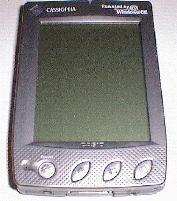
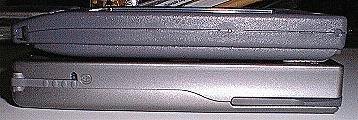
Comparing the look and feel of the E-10 with a Palm III, I would say that Palm III feels a bit smaller than the E-10. This is probably because the Palm III’s case is more rounded. The Casio is like a little brick…more like a PalmPilot. I think I prefer the textured case on a Pilot over the E-10’s smooth case. With regards to the sturdiness of the casing, the E-10 feels solid. When you shake the case, the stylus rattles a bit in it’s holder but this isn’t a big deal. The only real thing that I don’t like about the case is the battery compartment. The cover for the battery compartment kind of wraps around the side of the case. This in itself is fine, but the problem is that the seam on the side of the case wobbles a bit back and forth. I know I’m being extremely picky, but hey that’s me. One nice thing about the battery cover is that it is locked in place via a little switch. Don’t play with the switch though because everytime you move it to the unlocked position, it resets the Total Time Used setting for the battery. The backside of the E-10 also reveals a compact flash slot, reset switch, and speaker grill.
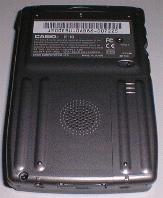
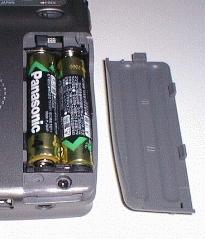
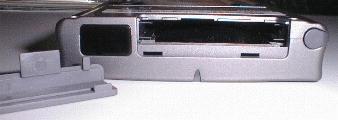
The E-10 has a total of 7 buttons (1 of those buttons is incorporated into the Action rocker switch. There are 4 buttons on the front of the unit. A power / backlight button, Calendar, Contacts, and To-Do’s button. On the left side of the case there is an Exit, Action (button / rocker) and Voice Record button. There is also an earphone jack on this side of the case. I like that the buttons are all set into the casing and can’t be accidentally pressed. They also all have a nice tactile feedback so the you know when you’ve pressed one. What I don’t like is that the side buttons are too small. The Exit button and Record button have to be pressed with your thumb nail. The Action rocker switch/button isn’t too hard to operate for right handed people since the edges are serrated like a gear. If you are a leftie, operating the side buttons isn’t too easy because you normally will be holding the unit in your right hand. This only allows you to use your fingers to access the side buttons and not your thumb like righties use.


The right side of the E-10 has the stylus silo and backup battery door. I like the stylus location. It’s easy to remove the stylus with an upward press of your thumb (for southpaws like me). The stylus fits nicely into the holder with a click. The stylus itself is one of the better ones I’ve used (doesn’t compare to a PDA Panache styli though). It is just the right thickness and length.
The backup battery door is interesting. There is a tiny switch that you have to hold while you slide the door lever down. You then have to swing this door lever away from the case. It took me awhile to figure it out.
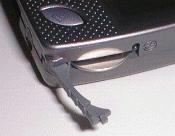
![]()
At the top of the case is a small V shaped LED. This red LED can be set to flash when an alarm you have set goes off. You have the ability to either use the LED by itself, or with a audible alarm. Unless you’ve got the E-10 sitting right in front of you, I doubt if you would see this small light flashing.
The bottom of the case reveals the serial port that is covered by a rubber boot. This boot has to be removed when you want to put the Casio in the cradle. The problem is that the boot isn’t attached to the case in anyway…. so it will be VERY easy to lose. The bottom of the case also has 2 mounting holes that are used by plastic pegs in the sync cradle.

As for the color of the E-10’s case, what’s up with this ‘grey’ thing?! Can’t someone come up with a better color than black or grey? If I recall correctly, some of the first pictures of the E-10 made the case look more blue… and the stylus had a orangish cap to it. Now that would have been nice… <sigh> I guess color doesn’t mean anything with regards to the units performance or function, but I like variety 🙂
Regarding the 4 grey scale LCD screen on the E-10… I’ve heard many people praising it as one of the best screens they’ve seen so far on a Palmtop. I’d have to disagree. It’s very good… but not the best. I’d rate the following PDAs that I’ve used/owned with the clearest and most readable non-color displays. First to last: REX, Newton MP2k, Psion 3a, PalmPilot/Palm III, E-10. I think I like the Palm III’s screen better because its blacks are really a bright black. The E-10’s screen does have more of an anti-glare screen compared to the Palm III. It also has more of a paper texture instead of the slippery screen of the Palm III. I’ll have to say that I really like the added screen resolution. I wish the PalmPilot used it’s entire screen like the E-10 does. 160×160 (Pilot) vs. 240×320 (E-10) does make a big difference. I also like the backlight on the E-10. It’s very bright. The only downside is that the backlight really eats the batteries. On my unit, I would sometimes turn the backlight on and after about 10secs. the E-10 would shut completely off. When I turned it back on, a message would pop up saying that they system powered off to protect the internal memory and that it suggested that I replace the main batteries. But upon going to the power application and checking the battery levels, both the main and backup batteries were marked as GOOD. More about batteries and power consumption later.
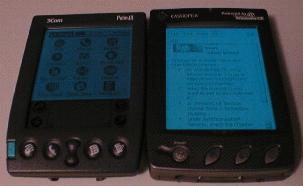
(The backlight looks blue here…. it’s really green)
A great feature of the E-10 is it’s voice recorder. With a touch of a button, you can record your voice, then play it back all without looking at the E-10’s screen. The playback quality is also quite good. It’s very clear unlike the Velo 500 that I had
reviewed not too long ago. You can name the recordings in voice notes application and beam them or mail them to someone. You are also given three different recording formats: Mobile Voice, PCM, and Truespeech. The different settings give you control over how much space is used for each second of recording and the quality of the recordings. Another nice feature is an earphone jack for listening to your recordings in private.
PCM Recording (68k)
TrueVoice Recording (5k)
The sound/speaker on the E-10 is great. It can do more than just beep and boop like the PalmPilot. It can actually play music, effects, etc. Here’s a tape of the Tetris game opening music (48k) that I recorded via my desktop microphone. The speaker also is good enough to let you use the E-10 to dial phone numbers using DTMF tones. I tested this with the smARTcommander software and it worked great. More about smARTcommander later.
One of the features that the E-10 shines with is the character input method. I really like Jot. I think it beats out the Palm III’s graffiti (this is coming from someone that is very good at graffiti). With Jot, you can choose between two character sets. Natural and Simplified. The Natural set is basically how you would normally write. A few of the characters are a little different, but most are normal. The Simplified set is more like graffiti in that there are quicker ways to write the characters. The online help for Jot actually has animations that show how to write the characters. This was neat because with both character sets, some letters have more than one way to write them. Another VERY nice feature is that you can actually see what you write when you are drawing the letters in the Jot area. The drawing area is almost identical to the Palm III. Except that it pops up when you need it, and goes away when you don’t. What makes it better than the Palm III’s graffiti area is that there is a middle area that when written in, makes the letter a capital letter. You also have the option to switch the number and letter area around… great for southpaws. And, the another nifty feature is that you can size the letter and number areas.
The Casio also comes with a nifty sync cradle. What’s nice about this cradle is that it can be made more mobile by removing the plastic back rest (see pic below). It also has an AC adapter jack built into the back of the cradle (an AC adapter is not included with the E-10 package though…and must be purchased separately). The E-10 fits easily into the cradle, but you have to hold the base of the cradle to remove the E-10. Unlike the PalmPilot cradle, there isn’t a sync button. The Casio cradle knows when you have inserted the PDA and will automatically initiate a sync. This is a nice feature but can get annoying if all you wanted to do was install a program. Fortunately, you can set things up so it only syncs when you tell it to.
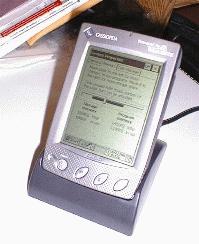
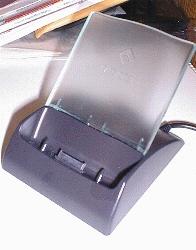
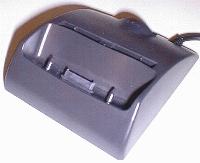
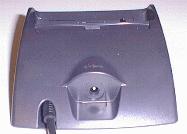
I did have some unusual problems with the serial communications and syncing. It seems that if I had Microsoft Frontpage running and synced the E-10, it would do something freaky to the Frontpage webserver so that I would have to shut it down and start it back up again. It also seemed to disconnect my modem if I was online and synced. I had the E-10 cradle on com1 and the modem was on com2. I’m not sure what caused these problems…
A nice feature of the E-10 is its compact flash slot. With this slot, you can add more memory to your E-10 easily… and you’ll need it if you start installing shareware and 3rd party apps. I noticed that apps for Windows CE machines are large! Much larger than the same type of apps on a Palm III. For instance, the Tetris game that comes on the bonus CD is about 74k. There are several Tetris games for the Pilot that are from 7k – 24k. I’m worried that 3rd party CE software will require that you get a compact flash card for your Palm size PC just to hold the bloated applications.
The major disappointment with the E-10 is that the battery life is quite short. I’m comparing it to my Palm III which can run for weeks on one set of AAA batteries (…and I use my Palm III alot). With the E-10, I got about 10-12hrs on the set of batteries that came with the unit. I also really didn’t like the power application. The only info it displayed for the main and backup batteries was GOOD, LOW and VERY LOW. All I ever saw it display was GOOD… this was even when it was shutting off automatically due to low batteries. The E-10 really needs a better power app that displays an actual voltage.
Many people have also complained about the system speed. I found it to be fine as long as I didn’t have lots of programs open at once. Even when I did have more than 10 or so apps open at one time, the delays weren’t horrible. You do see the little hourglass quite often on the E-10, but only for a second or so at a time. There really should be EXIT/CLOSE options for the programs. This way you don’t have to go to the systems app and shutdown programs to speed up the unit. Actually closing applications via the task manager is what was really slow! The E-10 isn’t as snappy as the Palm III, but it’s not a dog either.
The Casio E-10 also has a Infrared port. You can use this to send information to and from other Palm size PCs or to sync with your PC if it is equipped with an Infrared port. I was not able to test this part of the hardware.
Software:
The Casio E-10 uses Windows CE 2.0. So, if you’ve already used a Windows CE device, you’ll have no real learning curve with the E-10. The CDrom that comes with the E-10 is easy to install. It will install Windows CE Services. This is the PC desktop software that syncs the data on your E-10 with the data on your PC. You have the choice of syncing with Outlook or Schedule+. If you don’t have either, it will install Schedule+ for you. Once everything is installed, A folder is placed on your desktop called ‘Mobile Devices’. When your E-10 is in it’s cradle, you can look at all the files on it by opening the Mobile Devices folder. It is just like opening any other folder on your PC. You can copy and move files from other folders to and from this folder. The only really problem I found is that navigating through the folders on the E-10 is s-l-o-w. There are definite pauses as you go in and out of folders.
The syncing software is a snap. You can set things up so that as soon as you plug the E-10 into the cradle, it will automatically sync with the PC. The speed of syncing isn’t too bad. You can sync your email messages from Outlook or Microsoft Exchange on your PC to the Inbox on the E-10. You can then read and reply to messages on the E-10 when you’re away from your desktop. Then when you sync the E-10 with the desktop, the messages will be sent out. There are quite a few options that can be set with regards to the way you want your email on the desktop and E-10 to be synced. I was able to easily move messages to and from the E-10 and desktop using Microsoft Exchange.
The E-10 has another feature called Channels. This features lets you subscribe to web pages and have the content automatically update on your E-10. You can then view the channel data with graphics and sound on your Palm size PC. Unfortunately, I couldn’t get it to work. Everytime I would try to sync a channel on my PC to the E-10, it would tell me that I needed to install Internet Explorer 4.0 which I already had running on my system. I tried this several times and finally gave up. If someone can tell me what I might have done wrong, I’ll try it and then update this review.
Note Taker Application: This application will let you create text notes with sketches mixed in with the text. I really liked app once I figured out everything it could do. What I liked was the ability to add the ink drawings. What I didn’t like was that it was hard to edit the notes. The instructions were minimal and not very clear. I finally figured out that you had to press the SELECT button, then tap in the middle of a drawing and drag it to the desired location. One confusing aspect of this was that when a drawing is selected, it has little ‘handles’ around it and a cross hair in the middle. If you click on the cross hairs and drag your stylus, the drawing moves. But, you can’t click on one of the handles and resize the drawing even though that’s what it looks like you should be able to do. I thought for sure that I had done it once, but could never repeat it. (If anyone out there knows if a drawing can be resized, please let me know how to do it) One great feature that was barely mentioned in the manual was the ability to format the text and drawings. You have the options to have bold, underlined, italic, different line widths, different colors (dark grey, light grey, white), strike through, font sizes, fonts (Tahoma, Courier New). The notes files also sync to your PC and can be loaded into Word with all the font formats and drawings intact.
Voice Recorder Application: I liked this app. It let you make voice recordings without looking at the E-10’s screen. This is great for capturing ideas while driving. You can also play back, pause, rewind, and fast forward all with the Action button. The sound files are saved in .WAV format so they can be manipulated easily on your desktop PC. The files can also be filed in folders on the E-10.
Microsoft Pocket Outlook Applications (Calendar, Contacts, Tasks and Inbox).
Calendar: This application allows you to schedule meetings, appointments and other events with alarms that go off to remind you of them. It has a daily, weekly, monthly and a yearly view. The month view is unique in that it shows two clock dials for each day. One dial for AM and one for PM. Then if you have something scheduled during the day, the appropriate time slice of the dial is darkened in to show what slice of the day it is devoted to. Unfortunately, the yearly view is just like those little calendar cards that your insurance agent gives you.. This view isn’t very useful at all, it doesn’t give any indications of appointments on certain days or anything. It doesn’t even show the days of the week. You can tap on a date and jump to the day view of that day though. A nice feature of the calendar app is the ability to assign a category for an event, or meeting that you have entered. You can then do a sort based on a category. You can also edit the category list to add/delete entries. Another useful feature is that you can email a group of people to invite them to a meeting that you’ve scheduled in your E-10.
Contacts: This app is nice. It has a rolodex tabbed view with alphabetic tabs on the side of the screen to let you navigate quickly to a specific contact. You can configure how you which columns of information you want in the rolodex view. You can keep all kinds of info about a person in each contact record. It has separate home and work pages for each contact. You can also associate a category with each contact and then sort based on that category. The Contacts app is nicely done. I would use it quite often.
Tasks: This applications allows you to input to-do tasks with start date, end date, priority, and category associated with them. You can then check off items as you do them or be reminded via alarms when you’re over due. You can even set up reoccurring tasks. There’s not much more to say about the Tasks tool… it is simple to use and could be very useful to people that like to-do lists.
Inbox: Used to read and write email from your E-10. You can create folders to save your mail. Just like most mail tools, you can reply, forward, and delete messages. An address book can be used to keep email addresses. This address book is really just a list of all the people in the contacts tool that you have email addresses associated with.
There are several other miscellaneous programs that are also installed on the E-10. Of course there is a Solitaire game, which is basically the standard Windows Solitaire card game that we’re all familiar with. There’s also a basic calculator, and a world clock. A bonus CD of software comes with the E-10. There’s a Tetris game that’s mildly interesting. It would be much better if you could use the stylus instead of the action/rocker switch to move the pieces. There’s also a financial calculator, Quicken Expense app, a File Find utility, bFax Express, Meeting Minder, Casio digital camera viewer software and smARTcommander. The latter is the neatest thing I’ve played with in awhile. smARTcommander is a voice recognition app. Once you train it, it will respond to your command to dial a phone number, read a phone number, start an application, etc. There are 13 different commands that you can train it to do. I’d read several comments about this software in the newsgroups. Most people were saying it’s a joke or didn’t work. I found the opposite to be true. I trained it so if I would say ‘DIAL’, then a name out of my contacts app that I had trained it for, it would dial the phone number through the speaker. If I held the speaker up to my phone, the dtmf tones would actually dial the number. It worked great. I also trained it so when I would say ‘GO TO’, and then ‘SOLITAIRE’, it would start the solitaire game. What would make it really great is if it could read a file to you instead of just phone numbers.
After using the Casio E-10 for a week, I’d have to say that it’s a neat unit. Would I give up my Palm III in favor of it? Hmmmmm, I don’t think so. If the E-10 had about double the battery life, had buttons that were easier to use for a southpaw like myself, and had more shareware available, I’d really consider it though. If you’re trying to decide between buying an E-10 or a Palm III, you’ll have to ask yourself a couple of questions… Do you want lots of 3rd party apps available for your unit? Is battery life important to you? If you answered YES to the questions above then a Palm III might be your best choice. But, on the other side of the coin, you might want to answer these questions… Are you new to PDA’s, use Win95 and want a familiar interface? Is a voice recorder important to you? Will you be carrying large documents with you that might require the larger memory sizes of a compact flash card? If you answered YES to those questions, then it’s possible that the Casio is the better choice for you. Ultimately, it is best if you try out all the units that you have an interest in before you buy one.
Gerber Gear 22-47162N Fast Draw Folding Assisted Opening Pocket Knife, Fine Edge, Black
15% OffGerber Gear Suspension 12-in-1 EDC Multi-Plier Multitool with Pocket Knife, Needle Nose Pliers, Wire Cutters and More, Gifts for Men, Camping and Survival, Grey
9% OffProduct Information
| Price: | $399.99 |
| Manufacturer: | Casio |
| Pros: |
|
| Cons: |
|


